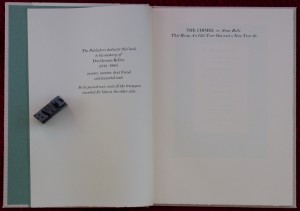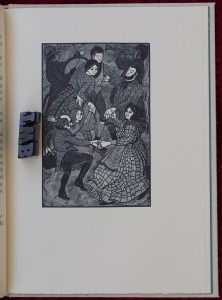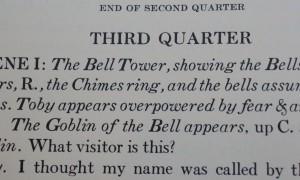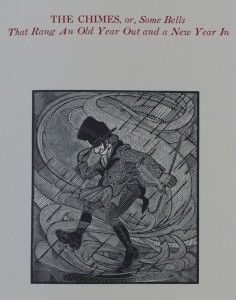 Ah, Christmas! What would it be without a little Dickens. I was all set to read the Cricket on the Hearth, which I have never read, when I realized that I still had the Barbarian Press stage adaptation of The Chimes also unread on my shelf. The full title of this edition is
Ah, Christmas! What would it be without a little Dickens. I was all set to read the Cricket on the Hearth, which I have never read, when I realized that I still had the Barbarian Press stage adaptation of The Chimes also unread on my shelf. The full title of this edition is
The Chimes: or, Some Bells That Rang an Old Year Out & a New Year In, a Goblin Drama in 4 Quarters; Adapted from Charles Dickens’ celebrated work by Mark Lemon & G. A. a’Beckett; First produced at the Aldelphi Theatre December 18th, 1844.
So for the second Christmas in a row, I have a fine press book to review for The Whole Book Experience. Not sure if I will be able to continue in this vein next year unless I am lucky enough to find the Barbarian edition of A Christmas Carol before the next holiday season. I’m not sure I know of any other fine press Christmas books. (More on that later…)
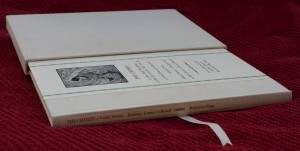 The Chimes was Dickens’ second Christmas book. It was written in 1844, a year after his incredible A Christmas Carol, and was followed by another three Christmas books: The Cricket on the Hearth, The Battle of Life, and The Haunted Man and the Ghost’s Bargain. One of the amazing things about these books is that stage adaptations appeared within days of their publication, almost all unauthorized, and all competing to satisfy the public’s appetite for a good Dickens Christmas story. The Barbarian Press used the authorized adaptation by Mark Lemon and G. A. a’Beckett that was first produced at the Adelphi Theatre on December 18th, 1844. This was a mere two days after The Chimes appeared in booksellers’ shops. Five more rival versions appeared or were announced within the month, according to Joel Kaplan’s insightful introduction to the play.
The Chimes was Dickens’ second Christmas book. It was written in 1844, a year after his incredible A Christmas Carol, and was followed by another three Christmas books: The Cricket on the Hearth, The Battle of Life, and The Haunted Man and the Ghost’s Bargain. One of the amazing things about these books is that stage adaptations appeared within days of their publication, almost all unauthorized, and all competing to satisfy the public’s appetite for a good Dickens Christmas story. The Barbarian Press used the authorized adaptation by Mark Lemon and G. A. a’Beckett that was first produced at the Adelphi Theatre on December 18th, 1844. This was a mere two days after The Chimes appeared in booksellers’ shops. Five more rival versions appeared or were announced within the month, according to Joel Kaplan’s insightful introduction to the play.
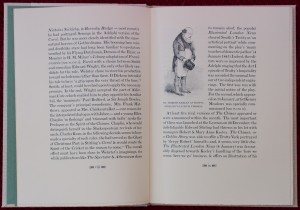 I can’t help but marvel that a book could generate six different stage adaptations within the first month of publication. That could never happen today due to copyright laws and the fact that our main theater experience has shifted from stage to screen, with no chance of bringing an adaptation out so quickly. Imagine the latest Harry Potter book comes out and we have six stage and/or film adaptations to choose from? Some versions would try to be true to the book, one might even be “authorized”, and others would vulgarize it into parody or farce or allegory. That would be interesting indeed.
I can’t help but marvel that a book could generate six different stage adaptations within the first month of publication. That could never happen today due to copyright laws and the fact that our main theater experience has shifted from stage to screen, with no chance of bringing an adaptation out so quickly. Imagine the latest Harry Potter book comes out and we have six stage and/or film adaptations to choose from? Some versions would try to be true to the book, one might even be “authorized”, and others would vulgarize it into parody or farce or allegory. That would be interesting indeed.
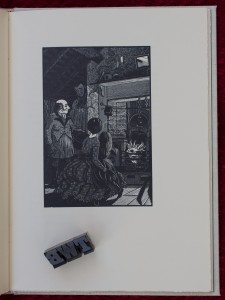 The Chimes is a sweet book full of the love of Trotty Veck for his daughter Meggy, and indeed for his fellow man in general. Typical of Dickens, he hoped to strike ‘a great blow for the poor’ with the book. And he does a good job of giving us a glimpse of the life of the London poor. Using the same method of alternate visions of the future that he employed in A Christmas Carol, Dickens has the Goblin of the Bell show Trotty several different possible outcomes of the life of Meggy, Lilian, and Richard.
The Chimes is a sweet book full of the love of Trotty Veck for his daughter Meggy, and indeed for his fellow man in general. Typical of Dickens, he hoped to strike ‘a great blow for the poor’ with the book. And he does a good job of giving us a glimpse of the life of the London poor. Using the same method of alternate visions of the future that he employed in A Christmas Carol, Dickens has the Goblin of the Bell show Trotty several different possible outcomes of the life of Meggy, Lilian, and Richard.
In his portrayal of Alderman Cute and Sir Joseph Bowley, he shows how the poor suffer from the misguided and frequently mean-spirited way the wealthy and the government perceive and deal with them. Alderman Cute wants to “put down” pretty much everything about the poor, whether it is hanging about on doorsteps, enjoying an honest meal out-of-doors, or even musicians joyfully playing in the new year. 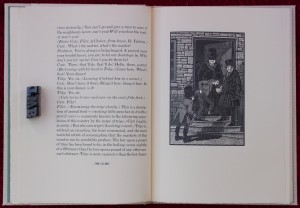 As Jabez is told by Cute’s footman, “Mr. Alderman Cute hates street musicianers, & he means to put ‘em down.” And this dialogue between Toby(Trotty) and Meg illustrates how helpless the poor can feel as they are being “put down”:
As Jabez is told by Cute’s footman, “Mr. Alderman Cute hates street musicianers, & he means to put ‘em down.” And this dialogue between Toby(Trotty) and Meg illustrates how helpless the poor can feel as they are being “put down”:
Toby. …But they’re always a-bringing up some new law or other.
Meg. And according to what I was reading you in the paper the other day, father – what the judge said, you know – we poor people are supposed to know ‘em all. Ha, ha! What a mistake! My goodness me, how clever they think us!
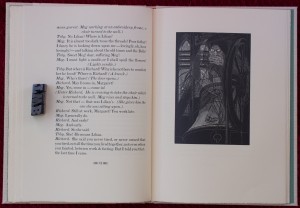 Sadly, I can imagine this same dialogue could be heard on the streets of any American city 150 years after this was written, as we still haven’t quite figured out how to deal with “the poor”. I thought The Chimes a great reminder of all I have to be thankful for this holiday season and to think charitably and kindly of those with less. And it was very interesting to read the stage adaptation in the Barbarian Press edition after reading the prose version many years ago. [I have the Easton Press facsimile of the Limited Edition Club book illustrated by Arthur Rackham. I hope to find the real thing at some point! Then I’ll have another book to review for a Christmas future]
Sadly, I can imagine this same dialogue could be heard on the streets of any American city 150 years after this was written, as we still haven’t quite figured out how to deal with “the poor”. I thought The Chimes a great reminder of all I have to be thankful for this holiday season and to think charitably and kindly of those with less. And it was very interesting to read the stage adaptation in the Barbarian Press edition after reading the prose version many years ago. [I have the Easton Press facsimile of the Limited Edition Club book illustrated by Arthur Rackham. I hope to find the real thing at some point! Then I’ll have another book to review for a Christmas future]
According to the notes in bibliography Hoi Barbaroi: a Quarter-century at Barbarian Press, the press originally set out to publish all of Dickens’ Christmas stories. As Crispin Elsted explains,
 “…we had badly overestimated the potential sales of A Christmas Carol, and proud as we were of the book, we could feel the vile breath of capitalism soughing about our ears. We decided to fix the edition of The Chimes at 150 copies.”
“…we had badly overestimated the potential sales of A Christmas Carol, and proud as we were of the book, we could feel the vile breath of capitalism soughing about our ears. We decided to fix the edition of The Chimes at 150 copies.”
And
“Despite the beauty of Colin’s engravings & the interest of the text, sales of The Chimes were disappointing, and we were finally forced to give up our plans for the remaining three Dickens adaptations. The counterpoise between commerce and common sense—which are, we feel, mutually exclusive—provides some of the more sensational moments of despair in the lives of private press publishers.”
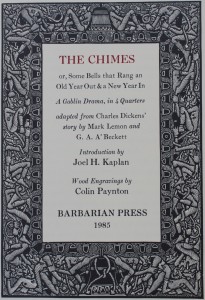 A sad reality check from my perspective 25 years later, since I hope to obtain A Christmas Carol someday and would love to also have seen at least The Cricket on the Hearth published. More’s the pity as this edition of The Chimes is a beautifully designed book. I’m not sure the team of Jan & Crispin Elsted has an equal when it comes to book design. Certainly some of the most beautiful books in my library are Barbarian editions. The cover of the book is stunning. The front cover has the title printed on a paper label along the whole length of the front cover. The title, subtitle, author information, and borders are printed in letterpress with three colors along with one of Colin’s engravings. (The green borders running up the sides of the cover label reminded me of the upcoming Barbarian Press book focusing on Curwen Press Borders. The book is titled Bordering on the Sublime and will be a treat for booklovers that are interested in this area of printing ornamentation). The illustrations by Colin Paynton are wonderful, and I really like the border he created for the title page. The addition of a ribbon to help remove the book from the slipcase is a nice feature not often seen, and is very useful given the buckram used on both the book and the slipcase.
A sad reality check from my perspective 25 years later, since I hope to obtain A Christmas Carol someday and would love to also have seen at least The Cricket on the Hearth published. More’s the pity as this edition of The Chimes is a beautifully designed book. I’m not sure the team of Jan & Crispin Elsted has an equal when it comes to book design. Certainly some of the most beautiful books in my library are Barbarian editions. The cover of the book is stunning. The front cover has the title printed on a paper label along the whole length of the front cover. The title, subtitle, author information, and borders are printed in letterpress with three colors along with one of Colin’s engravings. (The green borders running up the sides of the cover label reminded me of the upcoming Barbarian Press book focusing on Curwen Press Borders. The book is titled Bordering on the Sublime and will be a treat for booklovers that are interested in this area of printing ornamentation). The illustrations by Colin Paynton are wonderful, and I really like the border he created for the title page. The addition of a ribbon to help remove the book from the slipcase is a nice feature not often seen, and is very useful given the buckram used on both the book and the slipcase.
 Having a chance to spend some time reading and examining this early book from the press reminded me of why I’m always eagerly awaiting the next books from the Barbarians. I encourage you to spend some time with Dickens this holiday season and hope that you lived every day of the Old Year to the fullest when the Bells ring it out.
Having a chance to spend some time reading and examining this early book from the press reminded me of why I’m always eagerly awaiting the next books from the Barbarians. I encourage you to spend some time with Dickens this holiday season and hope that you lived every day of the Old Year to the fullest when the Bells ring it out.
[Availability] Despite the slow sales indicated by Crispin above, the edition eventually sold 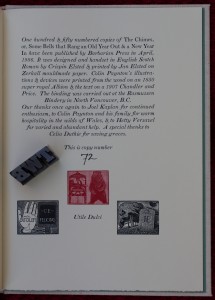 out. You can occasionally find them second hand at bookstores specializing in fine press, as well as on-line. I found mine at Wessel & Lieberman in Seattle and once saw A Christmas Carol at Moe’s in Berkeley. Alas, I didn’t/couldn’t make it mine at the time.
out. You can occasionally find them second hand at bookstores specializing in fine press, as well as on-line. I found mine at Wessel & Lieberman in Seattle and once saw A Christmas Carol at Moe’s in Berkeley. Alas, I didn’t/couldn’t make it mine at the time.
Since the press’ website does not give the details on this edition any more, I thought I would include the basics as described in Hoi Barbaroi:
Scotch roman and italic. Red & black on Zerkall mouldmade. Half natural buckram with centred strip of paper running from head to foot of upper cover, printed in red, green & black. Spine label printed down in red & black. Endpapers of Ingres Ivy. Slipcase of natural buckram over boards with green or white ribbon. 150 copies. $120.00


